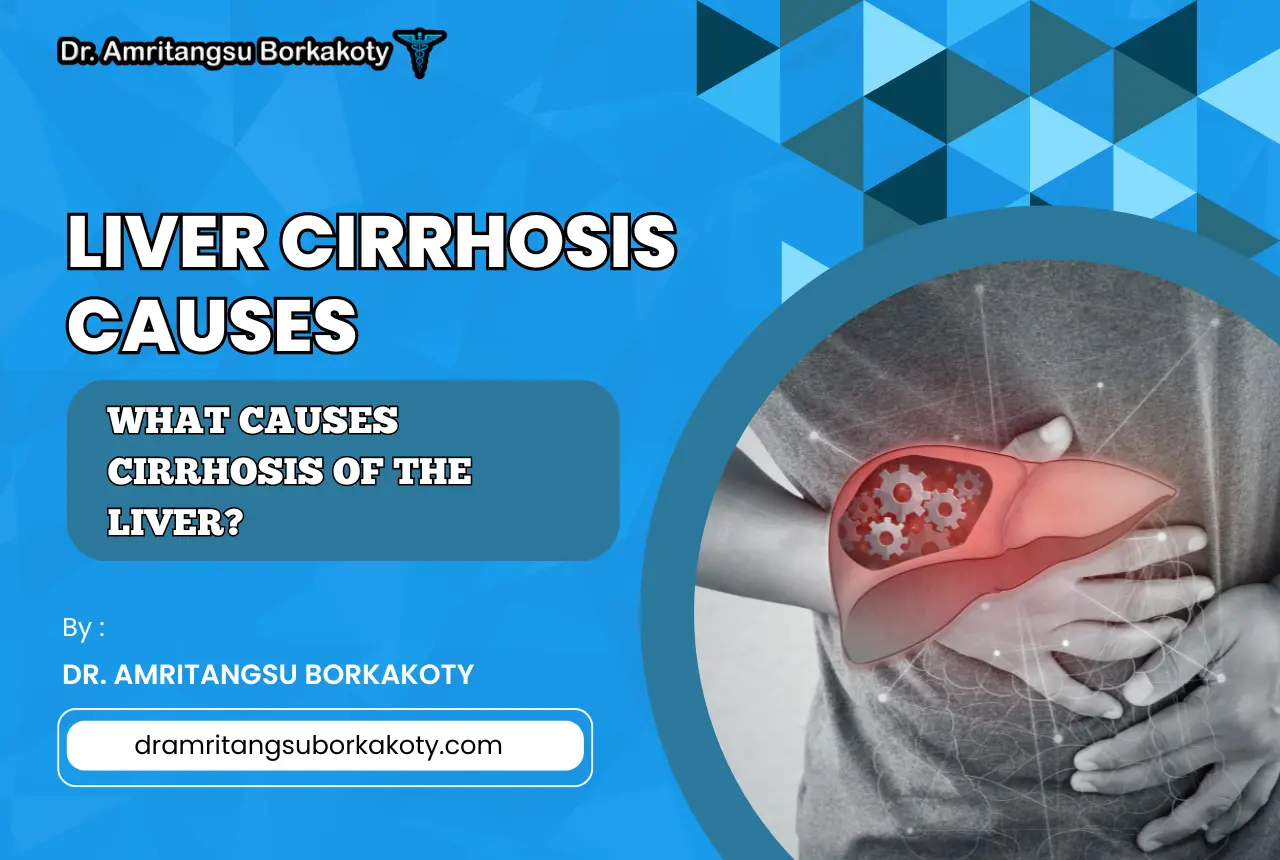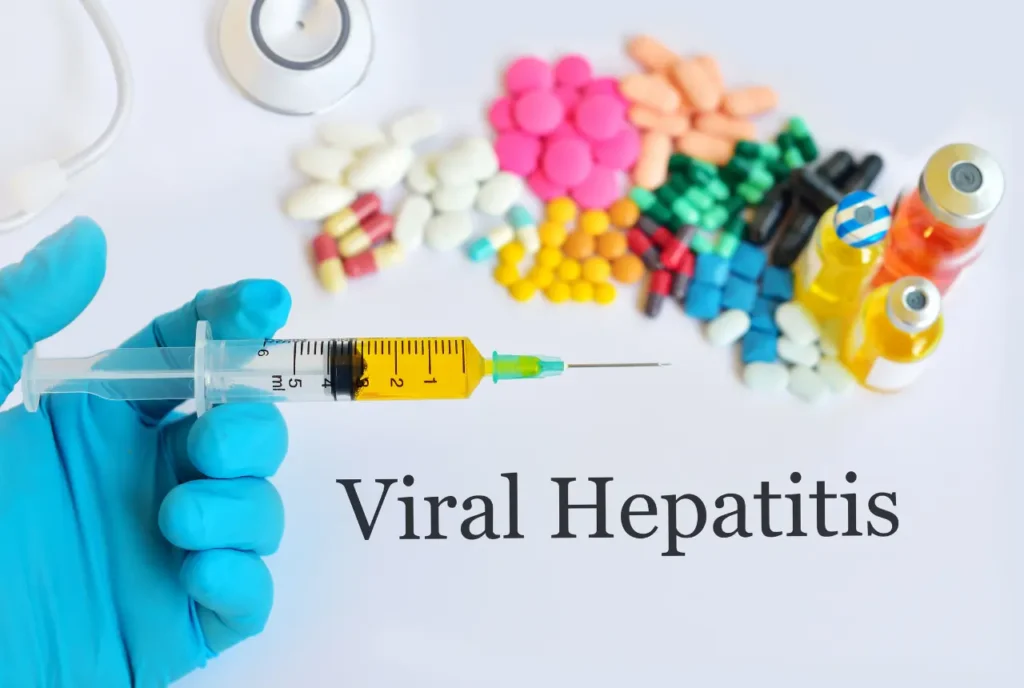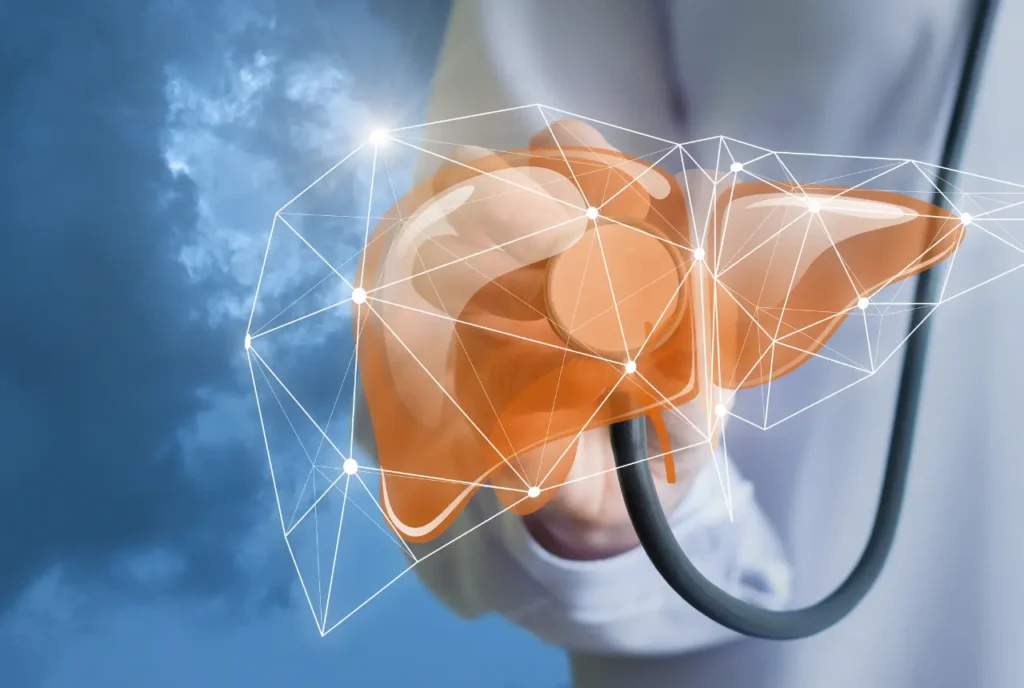
-
 Posted By Dr. Amritangsu Borkakoty
Posted By Dr. Amritangsu Borkakoty -
-
Comments 0
Curious about what causes liver cirrhosis, a dangerous disease that affects millions of people around the world? Liver cirrhosis occurs when healthy liver tissue is replaced by scar tissue, leading to impaired liver function. This progressive disease can result in liver failure and other severe health issues.
As the liver’s functions like detoxification, bile production, and energy storage decline, managing symptoms and slowing disease progression become crucial.
Early diagnosis and treatment are essential for improving outcomes. By understanding the causes of liver cirrhosis, we can take steps to prevent and manage this debilitating condition effectively.
In this blog, we explore the causes, symptoms, diagnosis, and treatment options for liver cirrhosis. Whether you’re seeking information for yourself or a loved one, learning about this condition is key to promoting better liver health and overall well-being.
Liver Cirrhosis Causes: Understanding the Underlying Factors
Cause 1: Alcohol-Associated Liver Disease (ALD)
Excessive alcohol consumption is a major cause of liver cirrhosis, as it damages liver cells in various ways. When alcohol is broken down in the liver, it creates toxic substances that cause oxidative stress and inflammation.
This process harms hepatocytes, the liver’s working cells, leading to cell death and the formation of scar tissue. Over time, if drinking continues, the liver’s ability to heal itself is overwhelmed, resulting in the gradual buildup of this scar tissue.
Alcohol-Associated Liver Disease (ALD) develops in stages. The first stage is fatty liver (steatosis), where fat starts to collect in the liver cells. This stage usually has no symptoms and can be reversed if alcohol use stops.
However, if heavy drinking persists, the disease can progress to alcoholic hepatitis, where the liver becomes inflamed and damaged.
Symptoms of this stage might include jaundice (yellowing of the skin), abdominal pain, and fever. Continued alcohol abuse leads to ongoing inflammation and damage, causing fibrosis and eventually cirrhosis. Cirrhosis is the last and irreversible stage of ALD, where extensive scarring severely impacts liver function.
To reduce the risk of ALD and cirrhosis, it is advised to stick to moderate drinking guidelines: up to one drink per day for women and up to two drinks per day for men. Following these limits can help prevent liver damage related to alcohol use.
Cause 2: Chronic Viral Hepatitis

Chronic viral hepatitis, particularly Hepatitis B and C, are major causes of liver cirrhosis worldwide. These viruses attack liver cells, leading to ongoing inflammation and damage.
Hepatitis B spreads through contact with infected body fluids like blood, semen, and saliva. Once in the bloodstream, the virus goes to the liver and replicates in the liver cells. The immune system then reacts to the infection, causing inflammation and damage. Over time, this continuous inflammation can result in fibrosis and eventually cirrhosis.
Hepatitis C is mainly transmitted through blood-to-blood contact, often by sharing needles or exposure to contaminated blood products.
Like Hepatitis B, the Hepatitis C virus infects liver cells and triggers an immune response. If untreated, chronic Hepatitis C leads to ongoing liver inflammation, fibrosis, and eventually cirrhosis.
Preventing Hepatitis B is possible through vaccination, which is safe and highly effective, greatly reducing the risk of infection and subsequent liver damage. Unfortunately, there is no vaccine for Hepatitis C, making early detection and antiviral treatment crucial to manage the disease and prevent cirrhosis.
Regular screening and timely treatment of viral hepatitis can significantly lower the risk of developing liver cirrhosis.
Cause 3: Nonalcoholic Fatty Liver Disease (NAFLD)
Nonalcoholic Fatty Liver Disease (NAFLD) is becoming more common, especially in developed countries, due to the increasing rates of obesity and metabolic syndrome.
NAFLD involves the build-up of excess fat in liver cells in people who drink little to no alcohol and is now the most common liver disease in Western countries, affecting up to one-third of adults.
The first stage of NAFLD is called hepatic steatosis, where fat accumulates in the liver. This stage usually doesn’t cause symptoms, but it can progress to a more serious condition known as nonalcoholic steatohepatitis (NASH).
NASH causes liver inflammation and damage, which can lead to fibrosis, cirrhosis, and even liver cancer. The exact process by which fat accumulation leads to inflammation and fibrosis isn’t completely understood, but it likely involves oxidative stress, lipid peroxidation, and the release of pro-inflammatory cytokines.
Several risk factors increase the chances of developing NAFLD, including obesity, type 2 diabetes, and metabolic syndrome (a group of conditions including high blood pressure, high blood sugar, excess body fat around the waist, and abnormal cholesterol levels).
These conditions cause insulin resistance and problems with lipid metabolism, leading to fat build-up in the liver. Managing these risk factors through lifestyle changes like losing weight, eating a healthy diet, and exercising regularly is key to preventing and managing NAFLD and stopping its progression to cirrhosis.
Additional Causes of Liver Cirrhosis
Besides the more common causes, several other conditions can lead to liver cirrhosis:
Autoimmune Hepatitis: This occurs when the immune system mistakenly attacks liver cells, causing inflammation and damage.
Bile Duct Diseases: Conditions such as primary biliary cholangitis and primary sclerosing cholangitis can cause blockages and damage in the bile ducts, leading to cirrhosis.
Genetic Disorders: Diseases like hemochromatosis, which causes excess iron buildup in the liver, and Wilson’s disease, which leads to copper accumulation, can both result in cirrhosis.
If liver disease is suspected, it is crucial to consult a doctor for a proper diagnosis and appropriate treatment.
Risk Factors for Liver Cirrhosis Development

Risk Factors for Liver Cirrhosis Development
There are several factors that can increase the risk of developing liver cirrhosis from different causes. These include:
- Family History: A family history of liver disease can increase the risk.
- Obesity: Being overweight, especially with abdominal obesity, is a significant risk factor.
- Type 2 Diabetes: Diabetes, particularly if poorly controlled, can contribute to liver damage.
- Exposure to Environmental Toxins: Certain toxins and chemicals can harm the liver over time.
- Chronic Alcohol Use: Excessive and prolonged alcohol consumption is a major cause of cirrhosis.
- Hepatitis B or C: Chronic infection with Hepatitis B or C viruses can lead to cirrhosis.
- Autoimmune Diseases: Conditions like autoimmune hepatitis and primary biliary cholangitis can increase the risk.
- Genetic Factors: Genetic disorders such as hemochromatosis and Wilson’s disease can predispose individuals to cirrhosis.
Understanding and managing these risk factors is crucial for preventing the development of liver cirrhosis. This includes lifestyle changes, regular medical check-ups, vaccinations (for Hepatitis B), and appropriate medical treatment when necessary.
Early Detection and Treatment Options for Liver Cirrhosis

Early detection of liver cirrhosis is crucial for effective management and better treatment outcomes. Recognizing common symptoms such as fatigue, jaundice (yellowing of the skin and eyes), and fluid retention (edema and ascites) is important.
Diagnosis:
Diagnosis of liver cirrhosis typically involves:
- Blood Tests: To assess liver function and detect markers of liver damage.
- Imaging Studies: Such as ultrasound, CT scan, or MRI to visualize the liver and assess its condition.
- Liver Biopsy: A small sample of liver tissue is taken and examined under a microscope to assess the extent of damage and confirm cirrhosis.
Treatment Options:
Treatment approaches for liver cirrhosis depend on the underlying cause and the severity of the disease:
Antiviral Medications: For Hepatitis B and C infections, antiviral medications can help manage the viral load and slow down the progression of cirrhosis.
Lifestyle Changes: For Nonalcoholic Fatty Liver Disease (NAFLD), lifestyle modifications such as weight loss, a healthy diet, and regular exercise can help reduce fat accumulation in the liver and prevent further damage.
Abstinence from Alcohol: For Alcohol-Associated Liver Disease (ALD), stopping alcohol consumption is crucial to prevent further liver damage and allow the liver to heal.
Medications: To manage symptoms like itching (pruritus), fatigue, or complications such as ascites and edema.
Liver Transplantation: In advanced cases of cirrhosis where the liver is severely damaged and cannot function properly, a liver transplant may be necessary.
Conclusion
Causes of Liver cirrhosis can arise from a variety of factors, such as excessive alcohol consumption, chronic viral hepatitis, and nonalcoholic fatty liver disease. Early diagnosis and treatment are vital for effectively managing the disease and preventing serious complications.
Adopting a healthy lifestyle, managing risk factors like obesity and diabetes, and seeking medical advice when necessary are crucial steps in minimizing the impact of liver cirrhosis. If you suspect liver disease or are at risk, consulting with a healthcare provider for proper evaluation and guidance is important for your health and well-being.
Recent Posts
- Common Causes of Stomach Ulcers and Effective Treatment Options
- Early Symptoms of Liver Damage: How to Spot the First Warning Signs Before It’s Too Late
- Best Treatment for Hepatitis B and C: Your Complete Guide to Symptoms, Care, and Prevention
- How to Reduce Liver Inflammation Fast: 5 Proven Tips for Rapid Liver Recovery
- Why You Shouldn’t Ignore NAFLD: 5 Shocking Health Risks You Need to Know


